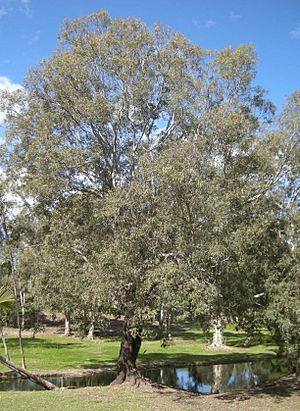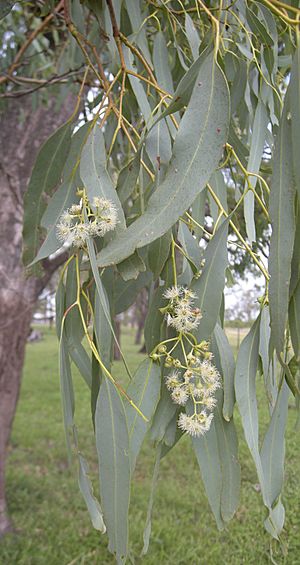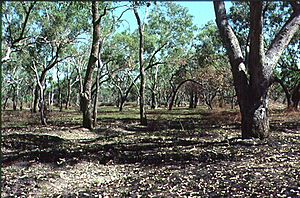Coolibah facts for kids
Quick facts for kids Coolibah |
|
|---|---|
 |
|
| Scientific classification | |
| Genus: |
Eucalyptus
|
| Species: |
coolabah
|
| Synonyms | |
|
|
The Coolibah (scientific name: Eucalyptus coolabah) is a type of tree found in inland Australia. It's famous for its rough bark on the lower trunk and smooth, colorful bark higher up. It has long, curved leaves, white flowers that grow in groups, and small, woody fruits.
Contents
What Does a Coolibah Tree Look Like?
Coolibah trees can grow up to 20 m (66 ft) (about 65 feet) tall. They have hard, rough, grey bark on their lower trunk, sometimes with whitish patches. Higher up, the bark is smooth and powdery. It can be white, cream, pale grey, or even pink! This smooth bark peels off in short strips.
Coolibah Leaves and Flowers
Young Coolibah plants have stems that are somewhat square. Their leaves are a dull bluish color and shaped like a spear. They are about 40–130 mm (1.6–5.1 in) long and 5–30 mm (0.20–1.18 in) wide.
As the tree grows, its adult leaves become dull green, bluish, or greyish. They are lance-shaped or curved, measuring about 80–170 mm (3.1–6.7 in) long and 10–25 mm (0.39–0.98 in) wide. These leaves grow on a stalk called a petiole, which is about 8–20 mm (0.31–0.79 in) long.
Coolibah flowers grow in groups of seven. Each group is on a short, flat stalk. The flower buds are oval-shaped and often have a waxy, bluish coating. They are about 3–5 mm (0.12–0.20 in) long. When the flowers open, they are white. You can see Coolibah trees flowering in most months of the year.
After flowering, the tree produces small, woody fruits. These fruits are shaped like a cone or half-sphere. They are about 2–4 mm (0.079–0.157 in) long and 3–5 mm (0.12–0.20 in) wide.
Similar Trees
The Coolibah tree is very similar to another tree called E. microtheca. The main difference is that E. microtheca has rough bark all the way up to its smallest branches. Another similar tree, E. victrix, has smooth bark all over its trunk and branches.
Where Do Coolibah Trees Grow?
Coolibah trees are found in many parts of inland Australia. You can see them in western New South Wales, central South Australia, the Kimberley region of Western Australia, western Queensland, and the southern and central parts of the Northern Territory.
These trees usually grow on flat plains that sometimes get flooded. They also grow along the banks of streams and creeks that don't flow all the time. Coolibahs are tough and can survive in places where other trees, like the River Red Gum, might not get enough water.
How People Use Coolibah Wood
Coolibah wood is very dense and strong. It has a reddish-brown center, which is much darker than the outer wood.
Indigenous Australians have used Coolibah wood for many important things. They made spears for hunting and tools for starting fires. They also crafted message sticks to send messages between groups. Coolamons, which are traditional wooden dishes, and throwing sticks were also made from this wood. In dry times, they could even get water from the roots of the Coolibah tree.
Images for kids
See also
 In Spanish: Coolibah para niños
In Spanish: Coolibah para niños




